Notating tricky tricks

Table of Contents
Introduction⌗
About 4 months ago I analyzed 13 ball juggling tricks selected for their unique features, from videos contemporary popular jugglers. These jugglers are Taylor Glenn, Zak McAllister, Kouta Oohashi, Wes Peden and Domenyk La Terra. They have all kindly given me permission to use their footage here.
Back when I was writing the original article it was difficult to notate these tricks with the existing notation systems. Can I write them down now with the new Rhythmic Catches (RC) and IMBO combined?
I will go over each trick, and describe the challenges and achievements of RC and IMBO.
Combining RC and IMBO⌗
I consider Rhythmic Catches to be a pattern notation, dealing mostly with the timing, height and directions of throws, and IMBO to be a throw notation, describing the path of a single throw. I will combine them by writing out an IMBO notation for every single throw in the RC, separated by a comma. If no IMBO is needed for a throw, it is marked with a dash -. A hold can be notated in IMBO without throw or catch marks.
In some of the longer RC patterns I have added whitespaces between the throws to improve the legibility.
Tricks⌗
Stacked synch 4b windmill⌗
These video clips from Taylor Glenn originate from this IJA Tricks of the Month.
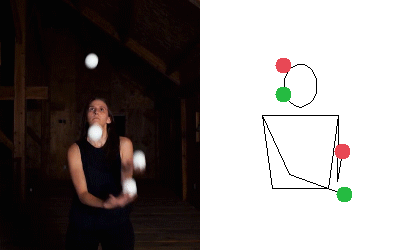
RC: (1s,1so)
IMBO: M~/H~\, /H~\H~
When you try to make a throw from M~ at the same time as a throw from neutral with the other hand, the only way to do this is with the hands above each other. Same for the catch. This means that with IMBO we can even describe the stacked balls.
This pattern can be fully notated with RC and IMBO.
Synch 4b claw multiplex⌗
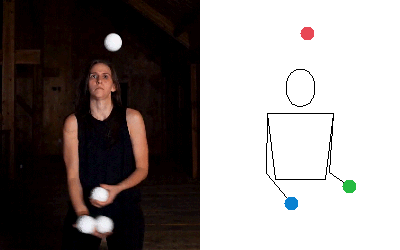
RC: ([12],2)-2-
IMBO: M~/\M~, M~/M~\, H~/H~\, /H\M
I chose to describe this as a 4 beat pattern, despite throws happening on only 2 of the beats and catches on only 3 of the beats. This way it feels like all beats are evenly spaced.
The carry is not described, nor is the multiplex with the two balls at the same height. If I were to read this notation I would assume a normal throw instead of a carry, and a multiplex with two balls at different heights. Also, the claw release and catch are not described.
This pattern can be partially notated with RC and IMBO.
Trace around with foot catch⌗
These video clips from Zak McAllister originate from DR POP.
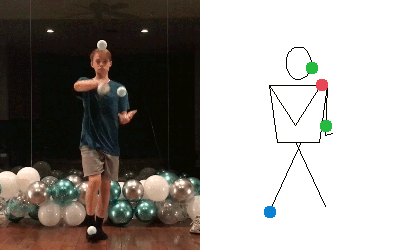
RC: ([1s2s~],h)(+1so,*F:2F)-
IMBO: M~/H~\, M~/M~\, H~H~, -, /HMH\M
I noticed that the second time I transcribed the IMBO, as I also did it 4 months ago, I notated the upper multiplex ball as M~/H~H~M~\, whereas this time I notated it as M~/M~\. As with all back and forth holes (like H~H~) this can be a bit arbitrary. I simplified the pattern notation this time for clarity, and I don’t think the little H~H~ pass is required for the trick, if you argue it even exists at all.
The IMBO paths perfectly describe how the holding hand must move, and RC takes care of the foot catch and the hand hit. In the previous article I also mention the difficulty of catching multiplexes not as a squeeze catch, the current notation with the ~ solves this albeit in a somewhat unusual manner.
This pattern can be fully notated with RC and IMBO.
Tape cassette⌗
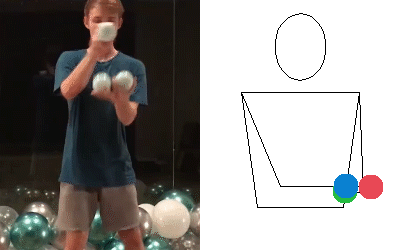
RC: [Hp:1sHp, h] h [h, Ht:1sHt] h, Hp: Hand pinky side, Ht: Hand thumb side
IMBO: M~/H~\, -, H~H~, -, M~/H~\, H~H~
Originally I have noted this in my notebook as RC ([Hp:0sHp, h] h)[h, Ht:0sHt]*, but with two extra beats I think the notation becomes more legible. Also, there is an odd use of a h within a multiplex throw, but this is necessary to explain that there is an extra ball in the hand.
The hand positions could be written using the default abbreviations, perhaps as Hf4&H for the pinky side and Hf1&Hf2 for the thumb side. However using Hf4&H:1sHf4&H in the notation seemed a bit annoying to read, so I chose in this case to create new simplified abbreviations. Either way, RC can be used to suggest the positions of the balls in the hand, which are important for this particular trick.
This pattern can be fully notated with RC and IMBO.
Fake mess under leg behind neck⌗
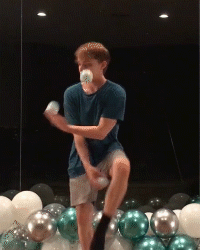
RC: 1(1s,h)
IMBO: H~/H\, -, LL
RC or IMBO do not describe that the leg is lifted up. However, when trying to execute the LL hold one will find that the solution on the video is the easiest solution. Therefor I’d say that the trick is correctly notated.
This pattern can be fully notated with RC and IMBO.
7423 slam⌗
These video clips from Kouta Oohashi originate from YAGAKU.
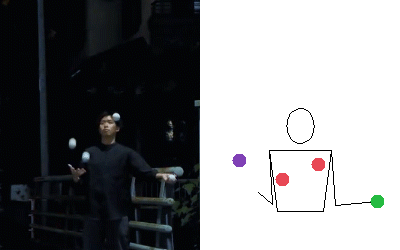
RC: 3 1o 2so 4 1s *1o 2s
IMBO: -, -, -, -, Mo/M\, -, -
With the one overhead throw, the easiest way to make the repeated hand outside throw (throw 6, *1o) is by raising that throw up as well. However, not necessarily as high as in the video. Is that a defining feature of the trick? That is probably up to debate. For the purpose of this analysis, I’m tempted to say no.
This pattern can be fully notated with RC and IMBO.
4b elbow trap⌗
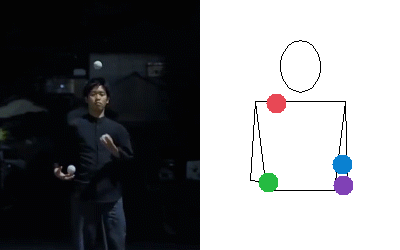
RC: 2(0Ep&Ky,Ep&Ky:0s)*
IMBO: -
Finally a pattern where the strength of RC’s multiple body parts is clearly shown. Sadly Ep&Ky is a long abbreviation, it could possibly be shortened to just elbow pit Ep. But especially if we generalize the pattern, replacing Ep&Ky with Bp for Body part, it would become obvious how we can recycle this pattern shape and use it in other body parts too. That would be 2(0Bp, Bp:0s)*.
This pattern can be fully notated with RC.
Over under cascade⌗
These video clips from Wes Peden originate from LEMONS.

RC: 1
IMBO: M~/M~M\M, M~/H~H\M
This pattern seems so simple on paper yet so pretty in the air, I hope we can discover more patterns like these by generating patterns using IMBO.
This pattern can be fully notated with RC and IMBO.
522 through⌗

RC: 20s*
IMBO: /H~\Mp, -
Sadly RC or IMBO can not describe the 0s ball going around the 2 ball.
This pattern can be partially notated with RC and IMBO.
423 carry around head⌗

RC: 112sh2-
IMBO: /M~\M~, H~/H~\, -, H~H, /M~M~\
I chose to notate this as a 6 beat pattern, despite there being only 4 throws, this made all the beats feel somewhat evenly spaced.
The most difficult throw to interpret in this pattern is /M~M~\. Even when knowing the catching hand came from h H~H, one may not be able to predict the ball passes on the outside of the forearm without seeing the video.
This pattern can be partially notated with RC and IMBO.
Pirouette hold behind neck⌗
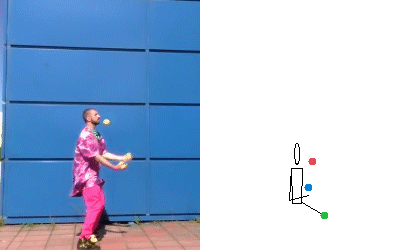
RC: 113shh*
IMBO: /H\H, -, -, H~H, HH~
There is no description for a pirouette included in RC or IMBO. Other than that the pattern can be fully notated.
This pattern can be partially notated with RC and IMBO.
Elbow zip in out⌗
These video clips from Domenyk la Terra originate from the IJA Tricks of the Month.
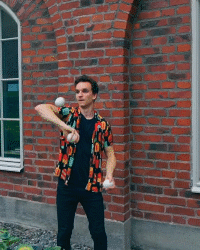
RC: (0Ei, *Ei:+1sEo)Eo:+1 1
IMBO: -
Another one for RC to shine. Hits, multiple elbow sites, hits directly after a zip, they are all easy to represent in RC.
This pattern can be fully notated with RC.
Stack slap sequence⌗
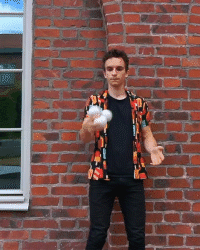
RC: [+1 2] +1 [2sHb 3s] *0 Hb:+2K *+0 *K:+2K - *(K:1, 2s) -*
IMBO: -
This sequence is long, I wish I had a simulator that could parse RC to test it. But I’m pretty sure I got it al right, and even with spaces it is definitely a lot shorter than the siteswap I had written originally:
<([42T],0)!|(0,0)!><(1,1x)!|(0,0)!><(3xp,[22])|(0,0)><(1,[22])!|(0,0)!><(0,1x)!|(1,0)!><(0,[222T])!|(0,1xp)!><(0,1x)!|(0,0)!><(0,[1322])!|(0,0)!><(2x,0)!|(0,0)!>*.
It’s shorter in part because I don’t need to write down the balls that are doing nothing in the hands any more.
I added 2 empty beats in the pattern to make the beats somewhat spaced evenly. There are a lot of repeating hands or sides in this pattern, making it perhaps a bit tricky to read at first.
This pattern can be fully notated with RC.
Conclusion⌗
So, how well are RC and IMBO able to describe these patterns?
Table⌗
| Trick | Can be notated? | Notations used | Missing features |
|---|---|---|---|
| Stacked synch 4b windmill | Yes | RC & IMBO | |
| Synch 4b claw multiplex | Partially | RC & IMBO | Claw catch & release, catch height, carry |
| Trace around with foot catch | Yes | RC & IMBO | |
| Tape cassette | Yes | RC & IMBO | |
| Fake mess under leg behind neck | Yes | RC & IMBO | |
| 7423 slam | Yes | RC & IMBO | |
| 4b elbow trap | Yes | RC | |
| Over under cascade | Yes | RC & IMBO | |
| 522 through | Partially | RC & IMBO | Ball position relative to other balls. |
| 423 carry around head | Partially | RC & IMBO | Special arm movements |
| Pirouette hold behind neck | Partially | RC & IMBO | Pirouette |
| Elbow zip in out | Yes | RC | |
| Stack slap sequence | Yes | RC |
9 out of these 13 patterns could be fully notated.
4 out of these 13 patterns could not be fully notated.
3 out of these 13 patterns only need to use RC, the others also use IMBO.
Is that bad?⌗
I think RC and IMBO did pretty well here. Going over the cases where it failed quickly:
In the Pirouette hold behind neck it is pretty simple to say “do a pirouette here” using any other form of communication than the given notation systems.
In the 423 carry around head and 522 through we’re dealing with some very rare features of juggling, being able to describe these could possibly make a notation system much more complex.
However, in the Synch 4b claw multiplex I must say I’m a bit disappointed by RC and IMBO. Not only are there multiple features that were hard to capture of this trick, also these features are seen quite commonly in ball juggling patterns. Perhaps they can be implemented in future versions of the notation systems.
Or is that good?⌗
The other 9 patterns were pretty straightforward to describe. I believe that a juggler who is proficient in reading these notation systems can replicate the tricks just from their notations, without needing a video reference. I am looking forward to the day when I can test these notation systems in simulation software.
Although this article does not attempt to do a systematic comparison between RC & IMBO and other notation systems, I strongly believe that they are the best candidates for all the tricks. Some individual patterns could have been described perhaps with for example just Beatmap, not all patterns and certainly not better than RC & IMBO. Perhaps Harmonic Throws would be able to describe these patterns, and even the ones that RC & IMBO didn’t manage such as a pattern with a pirouette or with claw catches, however it’s rigid rhythmical nature makes it unsuitable to describe tricks from videos that were not originally designed within the Harmonic Throws rhythmical structure.